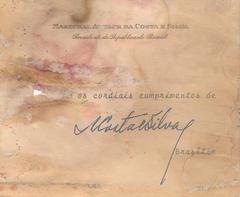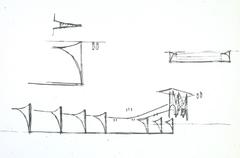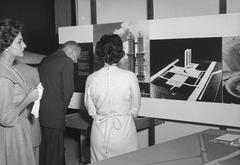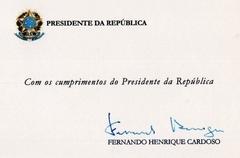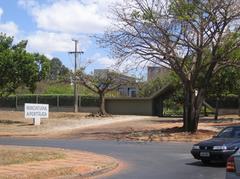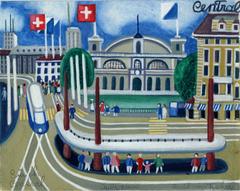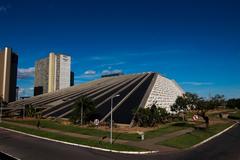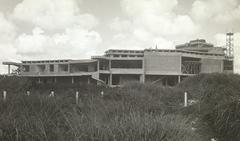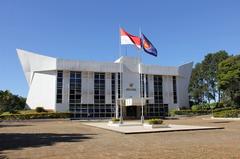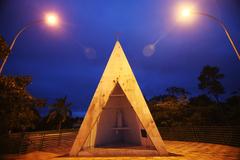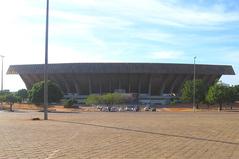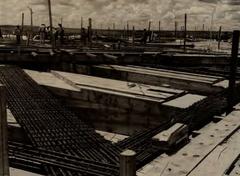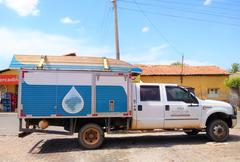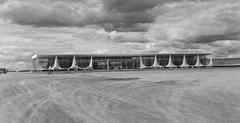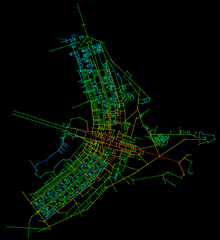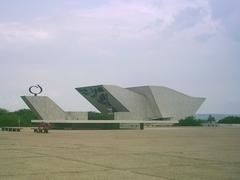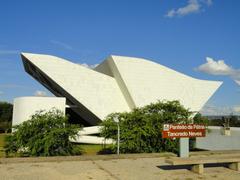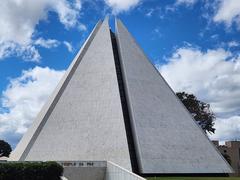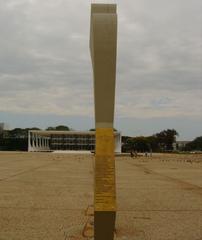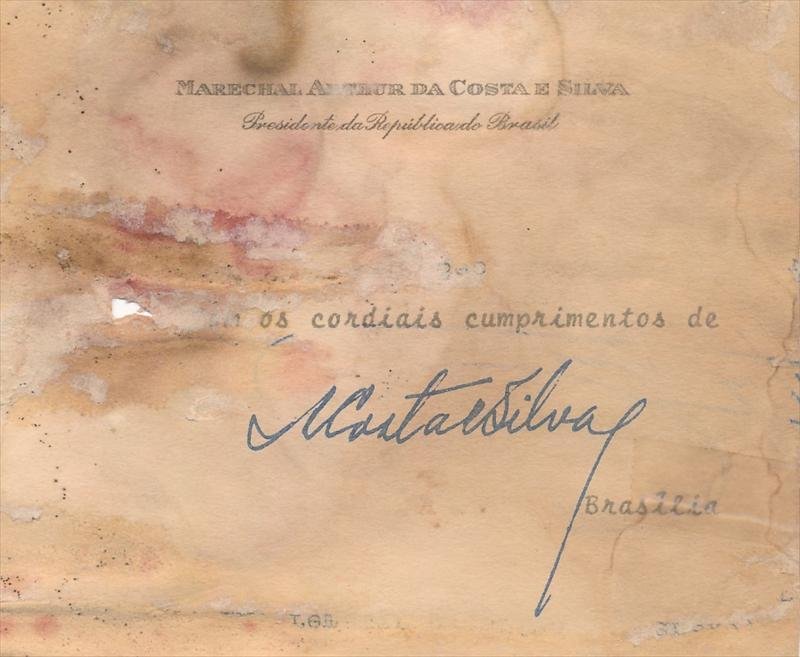
Palácio do Planalto Visiting Hours, Tickets, and Guide to Brasília Historical Sites
Date: 14/06/2025
Introduction
The Palácio do Planalto, located at the heart of Brasília, is not only the official workplace of the President of Brazil but also a masterpiece of modernist architecture and a symbol of the nation’s democratic aspirations. Designed by Oscar Niemeyer and inaugurated in 1960, it forms part of the iconic Praça dos Três Poderes, alongside the National Congress and Supreme Federal Court, embodying the core of Brazil’s federal government. The palace is celebrated for its architectural innovation, political significance, and cultural heritage, making it an essential destination for visitors to Brazil’s capital. This comprehensive guide provides everything you need to know about visiting the Palácio do Planalto, including its history, design, visitor hours, ticketing process, guided tours, accessibility, and nearby attractions. (Wikipedia; World History Journal; Forma Slova; Poder360)
Table of Contents
- Historical Background
- Design and Architecture
- Symbolism and Restoration
- Art and Culture
- Visitor Information
- Tour Experience Highlights
- Nearby Attractions
- Frequently Asked Questions (FAQ)
- Visuals and Media
- Conclusion and Call to Action
- References
Historical Background
The Palácio do Planalto is a central landmark in Brazil’s journey towards modernity and national integration. Its construction was a key element of President Juscelino Kubitschek’s ambitious plan to move the capital from Rio de Janeiro to Brazil’s interior, fostering national development and unity. The palace was inaugurated on April 21, 1960—the same day as Brasília itself—marking a new era in Brazilian governance and urban planning. Its location at Praça dos Três Poderes reflects the constitutional separation and balance of powers, with the executive, legislative, and judiciary branches represented side by side. (World History Journal)
Design and Architecture
Oscar Niemeyer’s vision for the Palácio do Planalto is a triumph of modernist architecture. The building is characterized by its slender white marble columns, horizontal lines, and expansive glass façades, which create a sense of transparency and openness. The iconic entrance ramp, inspired by both modernist and neoclassical motifs, leads to the main hall and sets the tone for the visitor experience. A reflecting pool in front of the palace, added in 1991, enhances both the aesthetics and environmental comfort of the structure. Covering 36,000 square meters over four levels, the palace integrates ceremonial spaces, offices, and art galleries in a cohesive, light-filled environment. (Forma Slova; Wikipedia)
Symbolism and Restoration
The Palácio do Planalto stands as a symbol of Brazil’s democratic ideals, with Niemeyer’s use of glass and open spaces representing governmental transparency. Its very name, “Planato,” refers to the Brazilian Central Plateau, highlighting the importance of the country’s interior. The palace also serves as a venue for significant state ceremonies, official receptions, and important national events.
After decades of use and the events of January 8, 2023, the palace underwent extensive restoration to repair structural damage and restore its art collections. The 2009–2010 restoration also modernized infrastructure and improved security while preserving Niemeyer’s original design. Preservation efforts are ongoing, ensuring that the Palácio do Planalto remains both a functional seat of power and a cultural monument. (Poder360)
Art and Culture
Inside, the Palácio do Planalto showcases works by celebrated Brazilian artists such as Athos Bulcão, Alfredo Volpi, Djanira da Motta e Silva, and Roberto Burle Marx. Art is integrated into the architecture, with murals, sculptures, and decorative panels enhancing ceremonial halls and galleries. The art collection is curated in collaboration with national heritage institutions to preserve its unique value. Cultural programming and temporary exhibitions are occasionally hosted, further enriching the visitor experience. (Forma Slova)
Visitor Information
Visiting Hours and Tickets
- Guided Tours: Available only on Sundays from 9:00 am to 1:00 pm.
- Tickets: Admission is free, but online booking is mandatory due to security protocols. Reservations must be made through the official platform, and visitors must present confirmation upon arrival.
- Group Size: Up to 30 people per group, with five groups admitted each Sunday.
Guided Tours
The guided tour lasts approximately one hour and covers three floors and the subsoil:
- Ground Floor: Introduction to architecture, history, and art.
- Subsoil: Exhibition space featuring works from the Presidential Collection.
- Second Floor: Salão Nobre (Noble Hall), Parlatório (veranda), and ceremonial ramp.
- Third Floor: Viewing of the Presidential Office doorway (photography prohibited).
The fourth floor, reserved for government offices and Athos Bulcão’s tile panels, is not open to the public.
Accessibility
- The palace is fully wheelchair accessible, with ramps and elevators.
- Assistance is available upon prior request for visitors with special needs.
Travel Tips
- Arrive 15 minutes early for security screening.
- Bring a valid photo ID and your reservation confirmation.
- Photography is allowed in most areas except the Presidential Office.
- Bags and backpacks are not allowed; lockers are available.
- Wear comfortable shoes for walking.
- Tours are mainly in Portuguese, but some guides offer English explanations.
Tour Experience Highlights
- Iconic Columns and Glass Façades: Exemplify modernist ideals of lightness and transparency.
- Entrance Ramp and Reflecting Pool: Combine function, ceremony, and architectural beauty.
- Art Collection: Features works by Brazil’s leading modern artists.
- Ceremonial Spaces: Salão Nobre, Parlatório, and Salão Oeste highlight the palace’s role in state events.
- Restoration Stories: Learn about the palace’s resilience and the ongoing efforts to preserve its heritage.
Nearby Attractions
- National Congress of Brazil: Twin towers and legislative chambers.
- Supreme Federal Court: Judicial seat with unique architectural features.
- Cathedral of Brasília: Oscar Niemeyer’s striking modernist cathedral.
- Itamaraty Palace: Ministry of Foreign Affairs, another Niemeyer highlight.
All are within walking distance of Praça dos Três Poderes, making it easy to explore Brasília’s cultural and political heart. (PlanetWare)
Frequently Asked Questions (FAQ)
Q: What are the Palácio do Planalto visiting hours?
A: Guided tours are offered only on Sundays from 9:00 am to 1:00 pm.
Q: How do I book a guided tour?
A: Book online through the official platform; confirmation is required for entry.
Q: Is there an entrance fee?
A: No, admission is free.
Q: Is the palace accessible to people with disabilities?
A: Yes, the building is wheelchair accessible.
Q: Can I take photographs inside?
A: Yes, except in the Presidential Office area.
Q: Are tours offered in English?
A: Most tours are in Portuguese; English explanations may be available depending on the guide.
Visuals and Media
- Front façade of Palácio do Planalto at sunrise (alt: Palácio do Planalto front view with reflecting pool at dawn).
- Interior view of Salão Nobre with Brazilian artworks (alt: Ceremonial hall inside Palácio do Planalto featuring national art).
- The ceremonial entrance ramp (alt: Visitors ascending the palace’s iconic modernist ramp).
For virtual tours and high-quality images, consult official tourism resources and reputable travel websites.
Conclusion and Call to Action
A visit to the Palácio do Planalto is an opportunity to witness Brazil’s architectural brilliance and democratic heritage firsthand. From its stunning modernist design and curated art collection to its pivotal role in national history, the palace offers an unforgettable experience for every visitor. Book your free guided tour online, explore the surrounding landmarks, and immerse yourself in the legacy of Brasília.
For the latest updates, tour booking, and travel tips, download the Audiala app and follow us on social media. Discover more about Brazil’s cultural treasures and plan your next adventure with confidence!
